| Her
Majesty Ashi Dorji Wangmo Wangchuck |
 |
Bhutan Royal Family |
|
 |
Bhutan Information |
|
|
|
| On
pilgrimage with Her Majesty Ashi Dorji Wangmo Wangchuck |
| Treasures of the Thunder Dragon |
 |
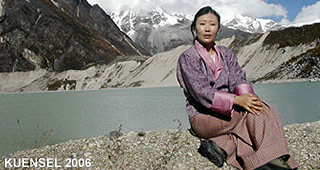 |
| Her
Majesty Ashi Dorji Wangmo Wangchuck in Lunana: the breathtaking scenery
and the aura of deep spirituality come together |
|
Ashi
Dorji Wangmo Wangchuck calls her new book
a portrait of Bhutan. It is far more than that. In unveiling the "Treasures
of Bhutan" she goes beyond the raw natural beauty of the country, into
its soul. Presented in an elegant narrative, it comes across like a
painting by someone who knows and feels deeply for the land and the people.
|
|
And,
for the Bhutanese reader, it is like going on a vividly perceptive voyage
across the length and breadth of the country with the author.
Published
by Penguin, the book begins with a comprehensive introduction followed
by three sections. In the first section Ashi
Dorji Wangmo describes herself literally
"growing with Bhutan", in the second she looks at traditional beliefs and
practices, and the third section is about people and places. The book
is about Bhutan and the Bhutanese.
|
A
personal experience |
 |
The
introduction, literally a journey across the country, establishes a backdrop
of Bhutan's unique evolution. The reader sees the dramatic geography,
senses the mythological history, and feels the excitement of change in
modern day Bhutan. It establishes a basis of the Bhutanese identity and, for an involved reader, culminates in the essence of Gross National
Happiness.
The
book conveys the sustainable harmony of Bhutanese society through
the eyes of a Bhutanese girl. This Nobgang family descends from known figures
of Bhutanese history but, with a rooster as the village alarm clock and
communal interaction best at the local water source, Ashi
Dorji Wangmo describes the social and
cultural values that bind our largely rural society. We see a childhood
that enjoys the warmth and security that most Bhutanese children still
know.
|
In
Kheng |
 |
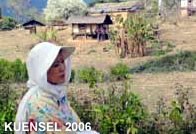 |
| Her
Majesty Ashi Dorji Wangmo Wangchuck in Kheng |
|
Bhutan
opened its doors cautiously in the early 1960s and one of the first priorities
was education. Her Majesty was among a few hundred Bhutanese students who
went to boarding school in the northern Indian hill stations at
a young age. The author is youthfully candid as she recalls her experiences
as well as her dreams in the adventures of boarding school. It is an experience
that the first generation of "modern" educated Bhutanese will recall with
nostalgia.
|
|
Ashi
Dorji Wangmo makes it clear that the book is born out of personal perceptions
and drawn entirely from personal experiences.
 |
| Brokpa people |
|
She
appears to enjoy best the times when she is able to avoid officialdom and make intimate contact with real people across the country.
Sharing
the hearth and home in village houses she is able to touch many poor families
in unreached parts of the country.
|
|
As
a writer she brings fascinating personalities alive, getting to know farmers,
weavers, students, herders, porters, reincarnates as she joins the
daily lives of the Layaps, Lhops, Monpas, Brokpas, Khengpas, and other
remote communities.
|
A
poetic narrative |
 |
The
narrative of "A portrait of Bhutan" is simple and rich in imagery.
As the author makes contact with nature and life she provides the readers,
not words, but the colours, the sounds, and the fragrance of Bhutan.
It is poetically graceful:
"As
darkness fell I looked out of the window to see the village bathed in the
golden light of a hundred electric bulbs while, down in the valley below, Shelgna
and Wangdiphodrang twinkled like a thousand stars."
The
tone and imagery highlight the breathtaking scenery and the aura of deep
spirituality that come together throughout the book.
The
reader senses the serenity of Hokotsho in Punakha, the drama
of Rangtse Nye in Samtse, the holy rock of Gom Kora in the east, and the rich biodiversity of Manas. Ashi
Dorji Wangmo Wangchuck goes out herself
to experience the real land of herbal medicines (lho jong men jong) through the therapeutic hot springs and the science of indigenous
herbal medical practice.
|
A
journey through time |
 |
As
the glacial lakes flow into folklore and Bhutanese history becomes a mythological reality the book is a voyage through time.
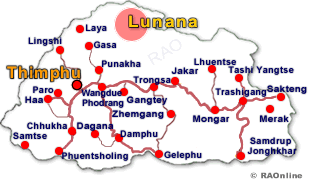 |
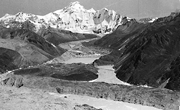 |
|
Glacial
lake in Lunana |
|
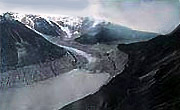 |
|
Glacial
lake in Lunana |
|
The
author recalls her 1963-trip to Thimphu which was then all paddy fields
and forest. She conveys the excitement of a historian who is documenting
living history and quotes visiting adventure writers of the past. From
those notes we see that parts of Bhutan has not changed.
Change
itself is both exciting and practical. Even as the author seems to regret
that the old wooden water channels are replaced by impersonal water
pipes, she portrays the images of development around the country.
As she begins her education the Thimphu-Phuentsholing highway is
built and her own village is transformed.
When
history comes alive, the past meets the present. Ashi
Dorji Wangmo touches on political intrigues
of the past that affected her family, like the assassination of the Zhabdrung
Jigme Dorji in 1931, an incident that was not clear to many Bhutanese.
All the perceived sensitivities, however, are clarified when His Majesty
the King visits Talo Monastery in 1988 and later commission a gilded
image of Zhabdrung Jigme Dorji.
|
Identity |
 |
As
nature and spirituality, history and culture, the land and people are merged
into a portrait of Bhutan what comes through is the distinct Bhutanese
identity. We see this throughout the book, not in the towns but on the
rugged ridges, in lush forests, in the lives of remote near-forgotten
communities.
"It
is thanks to them and others like them in rural hamlets scattered
across the country that Bhutan's distinctive culture, with its deep respect
for spiritual life, its close communion with nature and all its
elements, and its strong ties of family and community, survives
and thrives."
 |
| Nobgang
- on the ridge (left) |
Going
beyond the Shangrila that tourists search for the average reader
gets a better perception of well known religious images and historical
monuments, senses the intuitive reverence for local deities, appreciates
known social customs and eating habits, and sees age-old value systems,
thus getting a better understanding of the identity.
Ashi
Dorji Wangmo Wangchuck gives depth and
clarity to details of the traditional arts like people weaving cane
baskets in Zhemgang, artisans making dapas in Yangtse and hats in Sakten, women
weaving yathras in Bumthang and kushitharas in Kurtoe.
And,
when an old man in Zhemgang will not leave his home, despite an extremely
hard life, because of his identity, the reader is forced to wonder if young
Bhutanese will ever find that pride?
|
Gross
National Happiness |
 |
A
Portrait of Bhutan, as an experience, raises other valid questions. If Gross
National Happiness is the expression of a value system that has kept
Bhutan intact over the centuries are we overlooking the lessons of this
holistic system that is now visible only in some of our village communities? Ashi
Dorji Wangmo Wangchuck describes her view
of the traditional value system:
"A
combination of our religious beliefs, social values and customs and the
collective folk wisdom of a predominantly agrarian society such as ours
that helps to curb ecologically harmful practices, and makes the relationship
between the Bhutanese and their natural environment so close and harmonious."
|
That
is why it must be preserved: |
 |
"I
realised how important it is to respect, preserve and record their way
of life, which is an integral part of Bhutan's cultural heritage and to
ensure that their participation in the progress and development taking
place elsewhere in the country is at their own pace and on their own terms."
This
is an essence of GNH that we are quickly forgetting. These communities
are out of sight and, perhaps, might be out of mind in the future.
Conclusion:
Yet the reader must also ask, is this all too idyllic? With globalisation
already a reality, are we lost in romanticism? On the eve of historic changes,
when we face unknown challenges, are we looking for solace in the wrong
places?
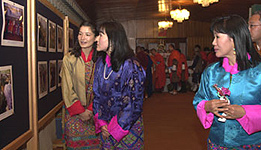 |
HM Queen Ashi Dorji Wangmo Wangchuck
and
HRH Ashi Kesang Wangmo Wangchuck
It
makes sense, then, that we go back to the teachings of Buddhism,
an underlying theme through the book. There are no external solutions to
our challenges and problems. We must look within. So the solutions to Bhutan's
problems lie within our own society. |
The
treasures of the Thunder Dragon, as we understand from this book, are
not material treasures.
The
elements that represent the foundation of the Bhutanese identity - the land and the people - offer the resounding message that Bhutan is
the treasure. It is a treasure that must not be forgotten- must not be
lost.
This
is a vital message because Bhutan is changing and we do not know if it
will be for the better.
As
the book ends Ashi Dorji Wangmo Wangchuck compares the real value of Bhutan with "the treasures sealed in a chhorten,
the seeds of journeys still to come-there are so many treasures of the
Thunder Dragon that still wait to be discovered."
The
reader can only wish that such discoveries will continue."
|
Book
launched |
 |
17
May 2006
"The
Treasures of the Thunder Dragon - A Portrait of Bhutan," Her Majesty Ashi
Dorji Wangmo Wangchuck's second book was
launched by His Royal Highness the Crown Prince, Jigme Khesar Namgyel Wangchuck,
in Thimphu.
Members
of the Royal Family, Trulku Gyelsey Tenzin Rabgey, Prime Minister Lyonpo
Sangay Ngedup and members of the Council of Ministers, senior government
officials and representatives from international organisations and agencies
attended the launching ceremony. |
|
|
Treasures
of the Thunder Dragon |
| On
pilgrimage with Her Majesty Ashi Dorji Wangmo Wangchuck
A
Portrait of Bhutan
Ashi
Dorji Wangmo Wangchuck; 2006;
Penguin
Books India
195
Pages; Nu./Rs. 495 |
|
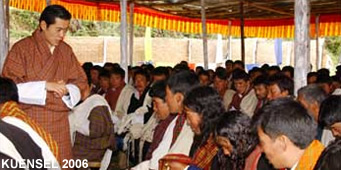 |
|
HRH
the Crown Prince, Jigme Khesar Namgyel Wangchuck |
|
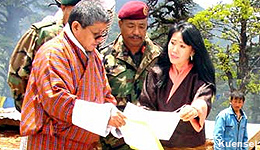 |
|
Her
Majesty Ashi Dorji Wangmo Wangchuck |
|
| Contributed
by Kinley Dorji, Kuensel, Bhutan's National Newspaper, 2006 |
 |
| information on Bhutan |
 |
 |
Nobgang Birthplace of the four Queens
|
|
 |
|













